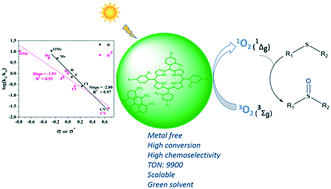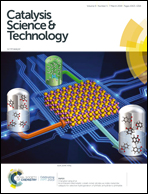Kinetic and mechanistic aspects of solid state, nanostructured porphyrin diacid photosensitizers in photooxidation of sulfides†
Abstract
In continuation of our studies on the photocatalytic performance of porphyrin diacids, the kinetics and mechanisms of the photooxidation of para-substituted phenyl methyl sulfides (para X = H, CH3, OCH3, Cl, and F) catalyzed by a series of meso-tetra(aryl)porphyrins (aryl = phenyl, 2-chlorophenyl, 2-methylphenyl, 4-chlorophenyl, 4-methylphenyl and 4-methoxyphenyl) immobilized on Amberlyst 15 nanostructures (nanoAmb), H2T(2 or 4-X)PP@nanoAmb, are reported. The immobilization of porphyrins on the polymer was confirmed by diffuse reflectance UV-vis spectroscopy and EDX analysis. While little or no catalyst degradation was observed for a reaction time of ca. 3 h, the electron-deficient porphyrins (pseudo-first-order rate constants, kobs = 0.0049–0.012 min−1) showed faster second-order kinetics than the electron-rich ones (kobs = 2.30 × 10−5–9.92 × 10−4 min−1). The order of photocatalytic activity of the porphyrins approximately correlates with the singlet oxygen quantum yield (φΔ) of the photosensitizers. Diffuse reflectance UV-vis spectra of the immobilized porphyrins demonstrated a large red shift of the Soret and Q bands of the porphyrins which was more dominant in the case of H2T(4-OMe)PP. The weak overlap between the emission spectrum of the light source and the absorption spectrum of the latter was used to explain the low photocatalytic activity of H2T(4-OMe)PP@nanoAmb. The observation of a slope (ρ) of −2.80 for the oxidation of methyl phenyl sulfide and para-substituted phenyl methyl sulfides is in accord with the involvement of an electrophilic oxidation mechanism mediated by singlet oxygen species. H2TPP@naoAmb was recovered and reused at least five times without significant loss of the catalytic activity and detectable catalyst degradation, giving a turnover number of 5 × 5000 for five successive reactions. The catalyst was successfully used for large-scale (up to 6.6 mmol of sulfide per batch, in a 1 : 10 000 catalyst-to-sulfide molar ratio) photooxidation of a wide range of sulfides to the corresponding sulfoxide in a water/acetonitrile solvent mixture.



 Please wait while we load your content...
Please wait while we load your content...